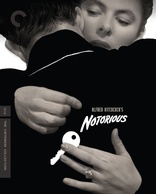Notorious Blu-ray Movie
HomeNotorious Blu-ray Movie 
Criterion | 1946 | 102 min | Not rated | Jan 15, 2019Movie rating
8.3 | / 10 |
Blu-ray rating
| Users | 4.5 | |
| Reviewer | 4.5 | |
| Overall | 4.5 |
Overview
Notorious (1946)
The daughter of a convicted Nazi spy is asked by American agents to gather information on a ring of Nazi scientists in in postwar Rio.
Starring: Cary Grant, Ingrid Bergman, Claude Rains, Louis Calhern, Leopoldine KonstantinDirector: Alfred Hitchcock
| Drama | 100% |
| Romance | 50% |
| Film-Noir | 44% |
| Thriller | Insignificant |
Specifications
Video
Video codec: MPEG-4 AVC
Video resolution: 1080p
Aspect ratio: 1.37:1
Original aspect ratio: 1.37:1
Audio
English: LPCM Mono (48kHz, 24-bit)
Subtitles
English SDH
Discs
Blu-ray Disc
Single disc (1 BD)
Playback
Region A (locked)
Review
Rating summary
| Movie | 4.0 | |
| Video | 4.5 | |
| Audio | 5.0 | |
| Extras | 4.5 | |
| Overall | 4.5 |
Notorious Blu-ray Movie Review
Reviewed by Dr. Svet Atanasov December 15, 2018Alfred Hitchcock's "Notorious" (1946) arrives on Blu-ray courtesy of Criterion. The supplemental features on the disc include vintage trailers for the film; archival audio commentaries with film scholar Marian Keane and film historian Rudy Behlmer; exclusive new video interview with cinematographer John Bailey; vintage documentary produced by David Thompson; and a lot more. The release also arrives with an illustrated leaflet featuring an essay by critic Angelica Jade Bastién and technical credits. In English, with optional English SDH subtitles for the main feature. Region-A "locked".
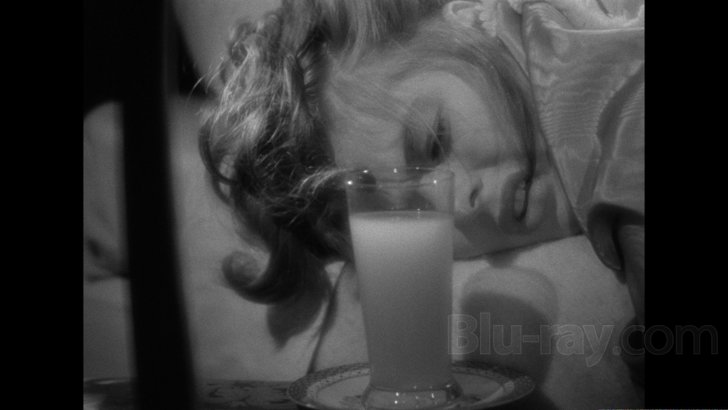
Drink it. You'll feel better.
The film is very much a product of its time and employs a number of old clichés to produce its crucial contrasts. What makes it interesting now is the effortless manner in which Alfred Hitchcock blends different genres and in the process manages to infuse it with multiple layers of atmosphere.
The beautiful and single socialite Alicia Huberman (Ingrid Bergman) has started drinking heavily because it is the only way in which she can suppress the shame she feels after her father was convicted of treason against the United States. She isn’t proud of herself but has not been able to find a replacement for the therapeutic effects of her alcoholism.
During a party Alicia is approached by Devlin (Cary Grant), a handsome government agent, and later on offered a way out of her misery -- if she agrees to spy on a few of her father’s prominent political friends in Brazil, no one would ever question her patriotism and the United States will forever be grateful for her service. The two then jump on a plane to Rio and Alicia’s assignment as an undercover agent officially begins.
Her primary target is identified as Alexander Sebastian (Claude Rains), an aging wealthy businessman living with his mother in a posh villa, who routinely hosts meetings for the key members of a powerful committee with direct ties to the German government. While following Devlin’s directions, Alicia quickly makes an impression on Alexander and then steals his heart. Just a few weeks later, and despite the objections of Alexander’s suspicious mother, a private wedding is arranged.
To keep his fiancée entertained, Alexander then throws a lavish party and Devlin concludes that it is the perfect opportunity for Alicia to steal a key that would let them in a room that might contain revealing information about the committee’s operations. They succeed and make an important discovery, but Alexander also realizes that he has been played, and when later on he attempts to hide from his comrades that he has failed to correctly profile his ‘wife’ and therefore jeopardized their work all hell breaks loose.
At the core of the genre overlapping that takes place in this film is the 'nothing is what it seems’ theme, but Hitchcock very carefully manages the evolving atmosphere and actually through it prepares the audience for the inevitable character transformations. In other words, the different twists that emerge are not what give the film its structure and ultimately its identity; it is the different layers of atmosphere and the manner in which they are synced with each other that do so.
The one aspect of the film that is clearly problematic is its expectation and confidence that Bergman can consistently shine so bright that she can legitimize the straightforward political messaging that is channeled through it. Essentially, Bergman has to say and do a lot of things ‘right’ to look believable as a frustrated alcoholic, patriot, and a hopeless romantic so that it appears that the messaging occurs naturally. Initially, she does handle the challenge -- the most noirish segment where she goes out for a wild night ride with Grant and nearly crashes her car in the palm trees is where she is at her best -- but the more complicated her mission becomes in Rio, the more she struggles and eventually her triumphs with Grant begin to look way too melodramatic. At this point Hitchcock is already finalizing all of the crucial contrasts so their authenticity suffers as well.
The two male stars, Grant and Rains, do not disappoint, but perhaps somewhat surprisingly it is the latter that leaves a very strong impression. His body language and attitude are pitch-perfect and truly the only reason why a few times the film quickly becomes genuinely dark and unsettling, as it should be in order for its story to be believable.
Notorious Blu-ray Movie, Video Quality 
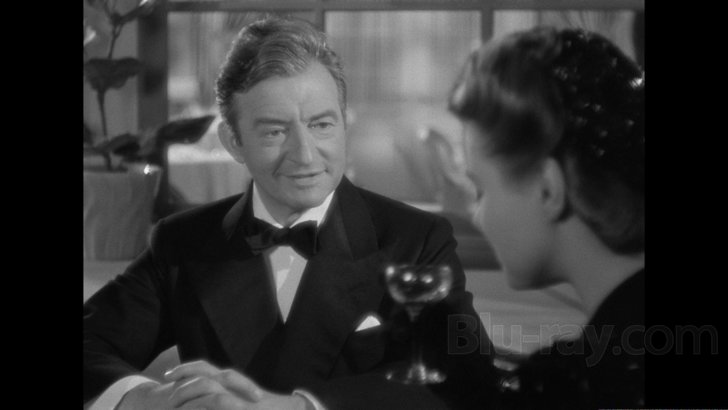
Presented in an aspect ratio of 1.37:1, encoded with MPEG-4 AVC and granted a 1080p transfer, Alfred Hitchcock's Notorious arrives on Blu-ray courtesy of Criterion.
The following text appears inside the leaflet that is provided with this Blu-ray release:
"This new digital restoration was undertaken by The Walt Disney Company and the Criterion Collection. A new digital transfer was created in 4K resolution on a Lasergraphics Director film scanner at Warner Bros. Motion Picture Imaging in Burbank, California, from three elements: the 35mm original camera negative and a 35mm nitrate fine-grain, both held by the Museum of Modern Art, and a 35mm safety fine-grain held by the British Film Institute. Several sections of the original camera negative, the primary source for this restoration, have sustained damage over the years and been replaced by duplicate negatives; for some of these portions, the fine-grains were used. Thousands of instances of dirt, debris, scratches, splices, and warps were manually removed using MTI Film's DRS, while Digital Vision's Phoenix was used for jitter, flicker, small dirt, grain, and noise management. The original monaural soundtrack was first restored in 2001 from a 1954 35mm acetate release print and a 35mm nitrate fine-grain master. Additional restoration work was performed by the Criterion Collection for this release, using Pro Tools HD and iZotope RX.
Scanning supervision: Theo Gluck/The Walt Disney Company, Burbank, CA.
Colorist: Lee Kline/Criterion Post, New York.
Digital scan assembly: Cara Shatzman/Criterion Post."
This upcoming release is sourced from a very nice new 4K remaster, and most viewers will immediately want to know how it compares to the older restored master that MGM used for the first high-definition release of the film in 2012. Here are the key differences that I saw while comparing the two releases:
I have projected both and the two most obvious improvements on the new 4K remaster come from the superior density levels and overall better grading. Now, there are areas of the film where existing source limitations still affect density in a way that is easily recognizable on the two releases -- delineation is impacted and the visuals become flatter across the board; in some cases clarity is also affected (screencapture #6 is from one such area where these limitations emerge). However, elsewhere close-ups boast a much better, and in some cases even dramatically better, density and delineation and as a result depth instantly becomes superior on the new 4K remaster (see screencaptures #1 and 5). Of course there is plenty of other footage where the difference is clear, but during close-ups the discrepancy is simply impossible to miss. Quite predictably, grain usually appears nicely exposed and resolved, not flattened or smeary.
On the other hand, clarity is not dramatically improved, but because of the superior grading on the new 4K remaster there are better ranges of grays and whites that work in sync with the blacks, and as a result fluidity is improved. To be perfectly clear, the new 4K remaster does not only have better ranges of finer nuances, it actually has a more appealing and better balanced organic appearance, and on a larger screen this becomes quite easy to recognize. Needless to say, the viewing experience is more satisfying as well. Image stability is very good. Lastly, from what I gather some sort of manual work was done to pick up and remove as many smaller imperfections and other less obvious age-related anomalies as possible, so the new remaster is also healthier. My score if 4.75/5.00. (Note: This is a Region-A "locked" Blu-ray release. Therefore, you must have a native Region-A or Region-Free player in order to access its content).
Notorious Blu-ray Movie, Audio Quality 
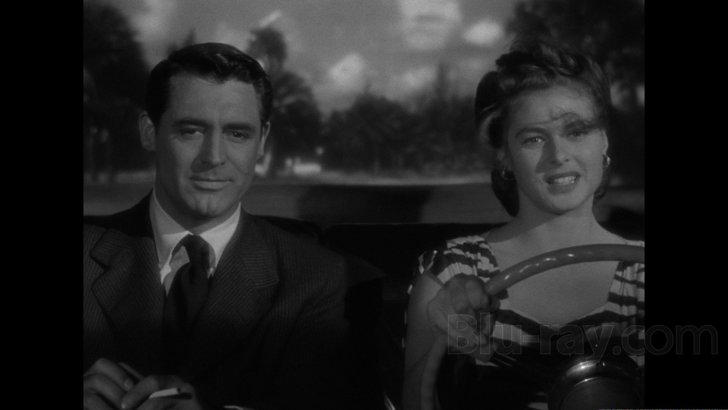
There is only one standard audio track on this Blu-ray release: English: LPCM Mono (48kHz, 24-bit). Optional English SDH subtitles are provided for the main feature.
The the basics of the original soundtrack are solid. However, its age immediately shows, so this means that you should have the proper expectations for the type of things that the lossless audio track can and cannot do. For example, while dynamic balance is very good -- which means that there are no sudden drops or spikes in dynamic movement -- the overall dynamic intensity is quite limited. Also, the depth does not have the type of ranges that other films from the late '50s and '60s, for instance, have. But this is how the original soundtrack was finalized, and these are the type of qualities that the lossless track recreates. The background is free of conventional age-related imperfections, such as hiss, hum, and distortions.
Notorious Blu-ray Movie, Special Features and Extras 

- Trailers - presented here are four vintage trailers for Notorious. In English, not subtitled.
1. "A Notorious Woman of Affairs!" (3 min, 1080p).
2. "Gems in Her Hair and Ice in Her Heart!" (1 min, 1080p).
3. "Notorious! Notorious! Notorious!" (1 min, 1080p).
4. "All She Was Was All She Wanted" (1 min, 1080p).
- Once Upon a Time... "Notorious" - David Thompson created this documentary for the French DVD series Once Upon a Time... in 2009. The material that is used in it addresses the socio-political climate in which Alfred Hitchcock directed Notorious and some of the key themes in it. It uses clips from archival interviews with the famous director, Claude Chabrol, Stephen Frears, film historians Bill Krohn and Sidney Gottlieb, biographer Charlotte Chandler, Isabella Rossellini, and Peter Bogdanovich, amongst others. In English and French, with imposed English subtitles where necessary. (52 min, 1080i).
- Powerful Patterns - in this brand new program, film scholar David Bordwell deconstructs the finale of Notorious and Alfred Hitchcock's management of the atmosphere throughout the film. The program was created exclusively for Criterion in 2018. In English, not subtitled. (30 min, 1080p).
- Glamour and Tension - in this brand new video interview, cinematographer John Bailey (The Big Chill, The Mafu Cage) discusses the visual style of Notorious as well as some key techniques that Alfred Hitchcock incorporated in his directing style over the course of his career. The interview was conducted exclusively for Criterion in 2018. In English, not subtitled. (24 min, 1080p).
- Powerful Patterns - in this new program, Donald Spoto, author of The Dark Side of Genius: The Life of Alfred Hitchcock, discusses Alfred Hitchcock's relationship with David O. Selznick, the production history of Notorious, and the film's narrative construction. The program was created exclusively for Criterion in 2018. In English, not subtitled. (21 min, 1080p).
- Writing with the Camera - in this new program, filmmaker David Raim examines the conception of Notorious, with a special emphasis on Alfred Hitchcock's involvement with the pre-production process. Included in it are clips from interviews with production designer Robert F. Boyle (The Birds), storyboard artist Gabriel Hardman, production designer Henry Bumstead (Vertigo), film critic and author Bill Krohn, and author Steven Katz, amongst others. In English, not subtitled. (16 min, 1080p).
- Lux Radio Theatre - this radio adaptation of Notorious features Ingrid Bergman, Joseph Cotten, Joseph Kearns, Gerald Mohr, and Janet Scott. It was originally broadcast on January 26, 1948. In English, not subtitled. (60 min, 1080p).
- Pathe Reporter Meets... - presented here is an archival newsreel in which Alfred Hitchcock welcomes Ingrid Bergman to the United Kingdom. The segment was shot in 1948. In English, not subtitled. (1 min, 1080p).
- Audio Commentary One - this archival audio commentary features Hitchcock scholar Marian Keane. The commentary was recorded exclusively for Criterion in 2001, and initially appeared on the label's DVD release of the film.
1. Self-referential
2. Figure of mystery
3. Battle of control
4. Masks
5. Topsy-turvy
6. Tied Together
7. Faith withheld
8. Surrogate screenplay
9. Misogyny and emasculation
10. Fantasy dispelled
11. Object for men
12. Perfect for the part
13. Deciding fates
14. nature of viewing
15. Not a perfect marriage
16. Mother and son
17. An answer for everything
18. The camera's capacity
19. Secrets unveiled
20. Sealed fate
21. Entirely exposed
22. Chronicle of demise
23. Laced with duplicity
24. The taking cure
25. Freedom
- Audio Commentary Two - this archival audio commentary features film historian Rudy Behlmer. It was recorded in 1990, and initially appeared on the label's LD release of Notorious.
1. Introduction
2. Controversy
3. Edith Head
4. Bergman fervor
5. "The Song of the Dragon"
6. Script development
7. The Selznick connection
8. "Away from the cliche"
9. Popular appeal
10. A devotee of film
11. Casting a key role
12. Hitchcockian point of view
13. "Actors are children"
14. Cary Grant
15. Love vs duty
16. Blending genres
17. Orchestrating suspense
18. A key moment
19. The impact of editing
20. Music
21. A charming villain
22. McGuffin
23. Complete breakdown
24. Alternate endings
25. "The satisfying ending"
- Leaflet - an illustrated leaflet featuring an essay by critic Angelica Jade Bastién and technical credits.
Notorious Blu-ray Movie, Overall Score and Recommendation 
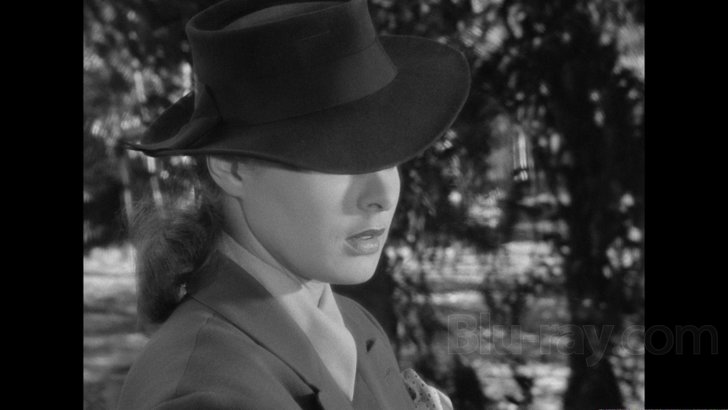
I am probably going to surprise a few people and almost certainly annoy many more by saying that the great things that happen in Notorious come from Claude Rains' performance. Indeed, whenever he is in front of the camera the film instantly becomes dark and tense in that very special Hitchcockian way, and you begin to expect the unexpected. Ingrid Bergman and Cary Grant are likeable together, especially early into the film, but I feel that way too much was required of the former to legitimize the political elements of the plot. Criterion's upcoming Blu-ray release of Notorious is sourced from a solid new 4K remaster that represents a good upgrade in quality over the previous master that was used for the first high-definition release of the film in 2012. It also has a good mix of archival and new bonus supplements. The one that I liked the most features cinematographer John Bailey, who has appeared on a number of Criterion releases and always has plenty of illuminating comments and stories to share. HIGHLY RECOMMENDED.
Similar titles
Similar titles you might also like

Rebecca
1940

Spellbound
1945

Gilda
1946

Shadow Dancer
2012

North by Northwest
1959

Allied
2016

Out of the Past
Warner Archive Collection
1947

The Black Book
Reign of Terror
1949

The Americans: The Complete First Season
2013

Incendiary
2008

The Red Shoes 4K
1948

Underworld
1927

Last Night
2010

Sweet Smell of Success
1957

On the Waterfront
Includes Elia Kazan: Outsider 1982 Documentary
1954

In a Lonely Place
1950

Gun Crazy
1950

Secret Beyond the Door
4K Restoration
1947

Sunday Bloody Sunday
1971

The Parallax View
1974
